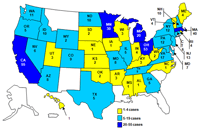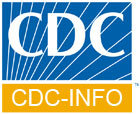Skip directly to the search box, site navigation, or content.
Investigation Update: Outbreak of Salmonella Typhimurium Infections, 2008�09
Persons Infected with the Outbreak Strains of Salmonella Typhimurium, United States, by State, September 1, 2008 to January 12, 2009

Update for January 12, 2009
Click Here for Advice to Consumers
CDC is collaborating with public health officials in many states and the United States Food and Drug Administration (FDA) to investigate a multistate outbreak of human infections due to Salmonella serotype Typhimurium.
As of Monday, January 12, 2009, 410 persons infected with the outbreak strains of Salmonella Typhimurium have been reported from 43 states. The number of ill persons identified in each state is as follows: Alabama (1), Arizona (8), Arkansas (3), California (55), Colorado (9), Connecticut (6), Georgia (5), Hawaii (1), Idaho (10), Illinois (5), Indiana (4), Iowa (1), Kansas (2), Kentucky (3), Maine (4), Maryland (7), Massachu setts (40), Michigan (20), Minnesota (30), Missouri (8), Mississippi (1), Nebraska (1), New Hampshire (10), New Jersey (13), New York (12), Nevada (6), North Carolina (1), North Dakota (10), Ohio (53), Oklahoma (2), Oregon (5), Pennsylvania (12), Rhode Island (4), South Dakota (2), Tennessee (9), Texas (5), Utah (3), Vermont (4), Virginia (17), Washington (11), West Virginia (2), Wisconsin (3), and Wyoming (2). Among the 388 persons with dates available, illnesses began between September 3 and December 31, 2008, with most illnesses beginning after October 1, 2008. Patients range in age from <1 to 98 years; 48% are female. Among persons with available information, 18% were hospitalized and the infection may have contributed to three deaths.
Outbreak Investigation
Preliminary analysis of an epidemiologic study conducted by CDC and public health officials in multiple states comparing foods eaten by ill and well persons has suggested peanut butter as a likely source. To date, no association has been found with common brand names of peanut butter sold in grocery stores.
An epidemiologic investigation by the Minnesota Department of Health suggested King Nut creamy peanut butter as a likely source of Salmonella infections among many ill persons in Minnesota. The Minnesota Department of Agriculture Laboratory isolated the outbreak strains of Salmonella Typhimurium from an open 5-pound container of King Nut brand creamy peanut butter. The product is distributed in Minnesota to establishments such as long-term care facilities, hospitals, schools, universities, restaurants, delis, cafeterias, and bakeries. It is not sold directly to consumers and is not known to be distributed for retail sale in grocery stores.
Clusters of infections in several states have been reported in schools and other institutions, such as long-term care facilities and hospitals, and King Nut is the only brand of peanut butter used in those facilities for which we have information.
CDC and other public health officials are continuing to conduct surveillance for cases of infection with the outbreak strains, and to gather and analyze data or exposures that may be associated with illness.
Advice to Consumers
To date, common brands of peanut butter sold in grocery stores do not appear to be associated with the outbreak. Persons who think they may have become ill from eating peanut butter are advised to consult their health care providers.
On January 10, 2009, King Nut Companies, a distributor of peanut butter manufactured by Peanut Corporation of America, issued a voluntary recall of peanut butter distributed under the King Nut label. In addition, King Nut Companies also issued a voluntary recall of Parnell抯 Pride peanut butter distributed by King Nut, which is produced by the same manufacturer. The recalled products have lot codes beginning with � No other King Nut products are included in this voluntary recall.
More information about this recall can be found on the FDA website at � http://www.fda.gov/oc/po/firmrecalls/kingnut01_09.html*
Clinical Features
Most persons infected with Salmonella develop diarrhea, fever, and abdominal cramps 12� hours after infection. Infection is usually diagnosed by culture of a stool sample. The illness usually lasts 4 to 7 days. Although most people recover without treatment, severe infections may occur. Infants, elderly persons, and those with impaired immune systems are more likely than others to develop severe illness. When severe infection occurs, Salmonella may spread from the intestines to the bloodstream and then to other body sites and can cause death unless the person is treated promptly with antibiotics.
More general information about Salmonella can be found at www.cdc.gov/nczved/dfbmd/disease_listing/salmonellosis_gi.html (Salmonella FAQs)
More information on this investigation can be found below.
- Minnesota Department of Health and Minnesota Department of Agriculture press release
- FDA Recall Notice
- More information on Salmonella
The next web posting is expected on Wednesday, January 14, 2009.
Previous Updates on this Outbreak
* Links to non-Federal organizations found at this site are provided solely as a service to our users. These links do not constitute an endorsement of these organizations or their programs by CDC or the Federal Government, and none should be inferred. CDC is not responsible for the content of the individual organization Web pages found at these links.
Content Source: National Center for Zoonotic, Vector-Borne, and Enteric Diseases (ZVED)
Quick Links
Contact CDC

